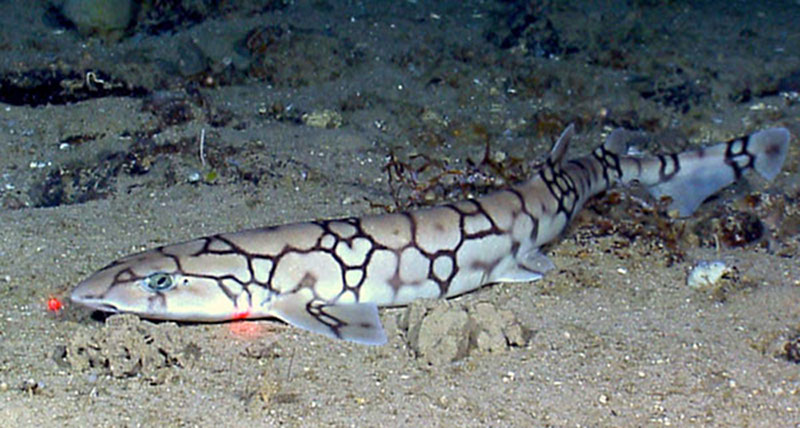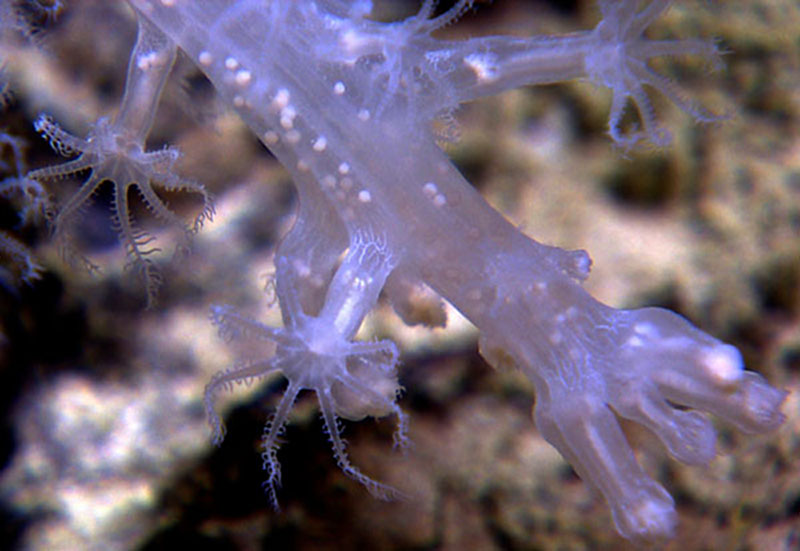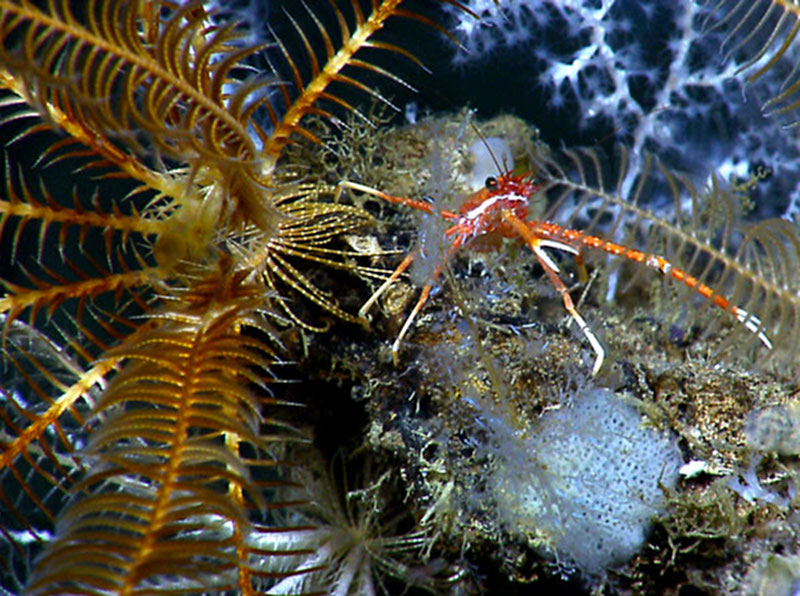
By Pen-Yuan Hsing, Graduate Student - Pennsylvania State University
March 22, 2012

The catshark (family Scyliorhinidae) we encountered on the dive. Sharks have more to fear from us than we have to fear from them. Image courtesy of the NOAA Office of Ocean Exploration and Research, Gulf of Mexico Expedition 2012. Download larger version (jpg, 740 KB).
As you may know, we had to cancel our dive yesterday due to opposing currents and winds that prevented the ship from staying still. The success of deep-sea research is often at the mercy of weather conditions. On the other hand, the cool thing about the deep sea is that we know so little about it, and there are always new places to explore! By yesterday evening, we started mapping surveys to pick a new site to dive on.
Video of a catshark encountered during an ROV dive from NOAA Ship Okeanos Explorer during the Gulf of Mexico Expedition 2012. Video courtesy of the NOAA Office of Ocean Exploration and Research, Gulf of Mexico Expedition 2012. Download (mp4, 38.9 MB).
What we decided on was an underwater ridge, about four kilometers south of our previous dive site. The remotely operated vehicle (ROV) went in the water at 0800 EDT (on schedule), and we eagerly awaited the discoveries ahead of us as the ROV descended to the seafloor. The dive plan was simple - start from the southern tip of the ridge, follow its western edge, and loop back from the east, ending the dive near where we started.
Video footage captured by the Little Hercules ROV and camera platform during the March 22 ROV dive from NOAA Ship Okeanos Explorer during the Gulf of Mexico Expedition 2012. Video courtesy of the NOAA Office of Ocean Exploration and Research, Gulf of Mexico Expedition 2012. Download (mp4, 169.1 MB).
We imaged many animals with the Little Hercules’s camera, and I was struck by the diversity of fish we encountered. About two thirds of the way through the dive, we discovered a catshark resting on the seafloor. It was a beautiful creature and looked so peaceful and content. The vast majority of sharks pose no threat to us - more people are killed every year by falling off of chairs than by shark attacks! In fact, sharks have a lot to fear from us.
Video of a swimming sea cucumber seen during an ROV dive from NOAA Ship Okeanos Explorer during the Gulf of Mexico Expedition 2012. Video courtesy of the NOAA Office of Ocean Exploration and Research, Gulf of Mexico Expedition 2012. Download (mp4, 54.9 MB).
Another exciting observation was a white, and almost translucent coral. When we zoomed in on it with the camera, you could see several white spots "floating" in its jelly-like body. According to Dr. Erik Cordes from Temple University, the spots are developing embryos - baby corals! When will they be born? How do they find a place to settle and grow in a vast ocean? The deep sea holds so many mysteries that we have barely begun to unravel. Even though Dr. Cordes is not on the ship, the live video streams from the Okeanos Explorer allowed him to join the dive virtually and make cool observations like this.

A “pregnant” coral. This is an octocoral, as evidenced by the eight tentacles you can see on its polyps. The white dots you see in its almost translucent body may be developing embryos – baby corals! Image courtesy of the NOAA Office of Ocean Exploration and Research, Gulf of Mexico Expedition 2012. Download larger version (jpg, 1.0 MB).
One of the last things we imaged was a group of crinoids on top of a rock. Right before the ROV started its ascent to the surface, the crinoids' arms started to move - not with the current, but on their own! It was like they were waving goodbye to us. Crinoids are known for their acrobatics, some species are even known to uproot themselves and walk or crawl along the seafloor.

A squat lobster (right) sitting next to a crinoid (left). This crinoid waved to us with its long, feathery arms as the ROV Little Hercules was about to leave bottom. Crinoids are quite nimble, some are even known to uproot themselves and walk along the seafloor! Image courtesy of the NOAA Office of Ocean Exploration and Research, Gulf of Mexico Expedition 2012. Download larger version (jpg, 1.0 MB).
Every deep-sea dive brings surprises and new discoveries and having a chance to be part of even one is an experience I will never forget.